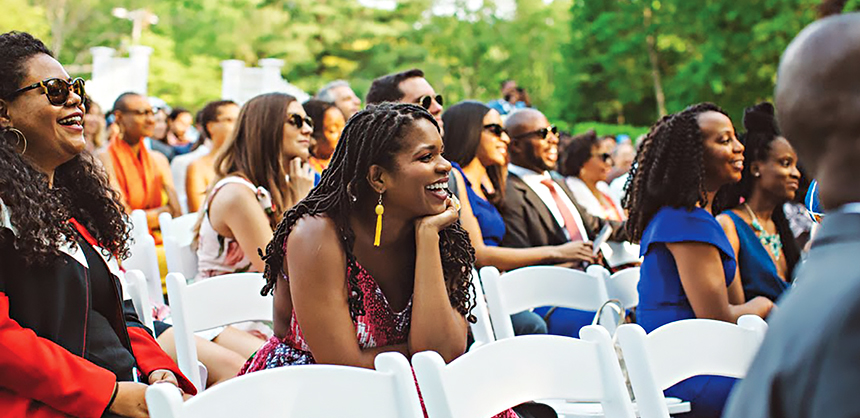Diversity & InclusionDecember 29, 2020
The Meetings And Events Industry Makes Strides To Ensure All Viewpoints Are Considered By Maura KellerDiversity & Inclusion
The Meetings And Events Industry Makes Strides To Ensure All Viewpoints Are Considered
DepositPhotos.com
Today, more than ever, it’s important to orchestrate diverse and inclusive meeting and event experiences. Of course, diversity and inclusivity today mean more than race and gender. Meeting planners are creating meeting and event environments where a variety of different voices are encouraged and heard. These same planners are starting to invest in other areas of diversity within the industry, including diversity of thought, generational, disability, personality type and sexual orientation.
“As a result of the increased focus on diversity and inclusivity, the event and meeting industry needs to adapt to changing times and welcome new talent and faces,” says Liang Zhao, CEO and founder of the events company Vansary, which works to bridge the gap between small businesses and corporate enterprises by creating virtual experiences that foster learning and connectivity. “We place a special emphasis on working with minority and women-owned businesses. We actively seek out organizations and communities to help foster communication. Organizers are now rethinking locations, marketing, messaging, channels, branding and food to help accommodate a more global and diverse audience.”
It is paramount that meeting and event organizers are cognizant of diversity because representation matters. “Events and conferences are highly visible,” Zhao says. “They draw international attention, and for many, it is a direct representation of an industry or topic. We, as event organizers, have a duty to our community, but also to the next generation to show young women and men that, regardless of their differences, they have role models before them that accomplished their dreams.”
According to Jumi Aluko, event planner at Jumi Aluko Consulting, the current business environment has become reflective of the current society at large. Messaging, products, services and content have all had to adapt to the shift in focusing on diversity and inclusion. “If businesses are not operating in a way that speaks genuinely about diversity and inclusion, people will take notice and speak on it,” Aluko says. “Because of this, the meetings and events industry needs to evolve to ensure that they are producing events that reflect the needs, wants and values of attendees.”
Deanna Nwosu, event planner and founder of Deanna Camille Events, says for many years there has been an initiative to focus more on diversity and inclusion; however, from her perspective, it has only really taken hold to boost the perception of the LGBTQ and Black, Indigenous, and People of Color communities. “This means we have signage and sponsorships regarding diversity, but I haven’t seen a concerted effort to make sure vendors are diverse, speakers are diverse, venues are diverse, etc.,” Nwosu says. “I believe as planners we need to shift and not think about diversity and inclusion solely from the lens of checking boxes, but are we open to things that are ‘unknown’ and ‘new’? Things like trying new ideas, reaching new audiences or including unknown speakers? In an attempt to minimize risk, I feel a lot of industry meetings, particularly, stick with what they know. But, if they’ll open themselves up to new ways of curating ideas and allow different people to be involved in decision making, I think that will result in a lot more ‘diversity of thought’ leading to natural inclusion of all.”
Nwosu says the main focus moving forward for diversity and inclusivity in events is ensuring supplier diversity and career advancement opportunities for minorities and other marginalized communities. “For example, it’s been known for years that, although women dominate the career of meeting and event planning — almost 75% — the ratio of women to men in upper management and executive roles pales in comparison,” Nwosu says. “Now that diversity and inclusion are high priorities for event industry leaders, top-down initiatives must be put in place to address inequities.”

Jumi Aluko, event planner at Jumi Aluko Consulting, says minority attendees will register for an event if the event’s diversity appeals to them. Photo courtesy of Jumi Aluko
Areas of Focus
As Aluko explains, if it’s not a focus, diverse groups beyond the usual may not feel they have a place in an event and ultimately won’t attend. “People are tired of seeing the same old people, content and messaging. They want to see new and unique events that speak to their respective life experiences and interests,” Aluko says. “They want to see things delivered in ways that meet them where they are — not that force them completely out of their comfort zone. If meetings and events don’t begin capturing this understanding, they will lose out.”
For example, when it comes to panelists, it’s important to be intentional about getting a diversity of individuals. Aluko suggests getting more people with minority backgrounds, more people of color, and racial and ethnic minorities who are underrepresented, so that each person who attends the meeting or event can say, “Hey, that person looks like me. We may have similar backgrounds. Let me attend and see what they have to say.”
Speaking of attendees, experts think the industry also has to do a better job of getting a more diverse mix of individuals to attend functions. As Aluko explains, one of the major barriers to attending events is often the price — certain groups, such as early career individuals and economically disadvantaged groups, sometimes get priced out of meetings and events, and these things become events only for the upper echelon. “The way we can work to reduce the cost to attendees is to reduce the expenses of productions, while also putting more effort into getting sponsorships and partnerships so that we aren’t trying to recoup money through ticket prices,” Aluko says.
When Aluko was younger, she wanted to attend certain meetings and events, but they were always incredibly expensive, so what did she do? She volunteered just so that she could be in the room — for free. “That may be another option — make more volunteer opportunities available and encourage economically disadvantaged groups to not only work the event, but to also create a schedule so they can attend the event as well,” Aluko says.
Nwosu also suggests that event organizers will need to be more proactive about diversity initiatives in the marketing and registration process. Do the photos on the event website represent multicultural attendees? Does the registration form ask about preferred pronouns? Similarly to how events are being made accessible to a variety of mental and physical abilities, meeting professionals need to consider the inclusivity aspect of welcoming people of various sexual and religious identities.
Annalisa Nash Fernandez, intercultural strategist at Because Culture, which focuses on cultural intelligence and cross-cultural strategy in technology and digital communication, says it’s critical to remember that when meeting planners choose what exactly to be diverse about, they are introducing a conscious bias by prioritizing values. Is gender more important for diversity than ethnicity? And do both exclude other values, like neurodiversity, and disability inclusion? Diversity of thought and experience should be the highest goal. Attack bias via culture, not color, she says. “Start seeding your event with the newest and best ideas,” Nash Fernandez says. “Fund scholarships for those people to attend, and the diversity will evolve naturally. But, until that effort matures, it’s simultaneously important to include that diversity at the highest event levels, so the newest human talent has allies and sees a path.”
Laura Manzano, founder and meeting planner at Manzano Hospitality, says the racial unrest this summer thrust diversity and inclusion into the national conversation. In a short amount of time, diversity and inclusion has become a top requested theme for keynote speaker selection and content planning. “At their core, meetings and events are an opportunity to connect, communicate and learn,” Manzano says. “With people coming together across cultures, geographies and professional backgrounds, a more diverse and inclusive environment can lead to a more enriching experience for a meeting or event.”
While diversity and inclusion are currently reflected prominently in keynote speaker selection, there are easy ways to proactively solicit diversity and inclusion in a more comprehensive way that weaves diversity and inclusivity into the fabric of a meeting or incentive. “Beyond getting the diversity and inclusivity conversation started, it can be integrated into a meeting and event process in an intentional way that ensures diversity and inclusivity throughout the life cycle of an event,” Manzano says. Beginning with the RFP process, clients can drive the D&I conversation by asking vendors at every level if they identify as a woman-owned business, a minority-owned business, an LGBTQ-owned business or a small business. The designations need not be mutually exclusive, and asking the question can heighten awareness, and help weave diversity and inclusivity into the fabric of an event.
The vendors involved in an event could also be asked to accept and pledge that their businesses are committed to such things as equal opportunity and equal pay, giving back to the local community, and community-specific social justice issues. “Much the same way businesses were able to reshape their practices to be green and restaurants embraced farm-to-table cuisine, meetings and incentives can lead the way to a more diverse and inclusive reality,” Manzano says.
At Manzano Hospitality, they focus on C-suite events. Executive events are often centered around thought leadership and the future of any given industry. “The CEO Action for Diversity & Inclusion [pledge] already boasts 1,800 members,” Manzano says. “If a meeting planner needs a compelling reason for a company to adopt diversity and inclusive-friendly initiatives, they should look to this list to see who of their competitive set is already ahead of the curve on this topic.”
For Zhao, key metrics for defining diversity and inclusivity success include the diversity of speakers, attendees, company types and accessibility, including price point and time. Beyond the individuals and companies represented at the conference, Zhao, like Aluko, says one aspect of inclusion that organizers should be more thoughtful about is the price point. “Oftentimes, those who would benefit the most from access to conferences and events are the ones with the least number of resources in time and money,” Zhao says. “In order to build more inclusive events, we need to make access easier.”
For example, Money20/20 has always been a conference focused on the future of money, which has traditionally been a male-dominated industry. “This year, they have done a great job building an agenda with a diverse pool of speakers and were inclusive of age, gender, origin story, orientation, seniority level and topic,” Zhao says. “They also made the content accessible through different pricing tiers, with panels and networking free for limited registrants.”

Candid picture of a business team collaborating. Filtered serie with light flares and cool tones.
Embracing Challenges
The first major challenge with ensuring meetings and events are diverse and inclusive is having the right people involved in planning the event. As a Nigerian-American event planner, Aluko is always taken aback at the lack of diversity in this field. “If there are not racial and ethnic minorities at the helm of planning, the event is already at a disadvantage when it comes to being diverse and inclusive,” Aluko says.
Another major challenge is establishing a thorough understanding among meeting and event planners about what it means to create a diverse and inclusive event. To overcome this, Aluko suggests that there needs to be more training and conversations. There needs to be post-event surveys completed by attendees that specifically address diversity and inclusivity so planners can use the feedback to improve their meetings.
Another challenge is budget. Budgets for producing meetings and events are already high. “The challenge becomes how can planners increase, or better yet, redistribute, funds to add the resources they need to ensure meetings are diverse,” Aluko says. “Resources include things such as a diversity and inclusivity consultant to work with throughout the planning process, and partnerships with local community organizations that can help with outreach to diverse communities, marketing, or for pre/post event programming.”
Nwosu says another big challenge is to get buy-in from stakeholders to focus on diversity initiatives and actually measure the results. “While individuals may not feel they treat anyone different based on their race, gender, religion, sexuality, etc., some fail to acknowledge that systemic racism is much bigger than any individual person,” Nwosu says. “Too often, those in leadership use a ‘do-nothing’ strategy expecting diversity to magically happen, but it doesn’t work that way.”
Learning From Mistakes
The biggest mistake Aluko sees being made as it relates to diversity and inclusivity is the unbalanced focus on ability and personal characteristics, and not enough on culture and race. For example, as Aluko explains, the conversations around diversity and inclusivity have brought us to the point where we ensure there are gender-neutral bathrooms, lactation/mother rooms, disability access, prayer rooms, etc., but we need to extend this conversation even further. “The focus on diversity and inclusion needs to start when you conceive of the idea or purpose of the event or are re-visiting the previous year’s event,” Aluko says. “It needs to be intertwined in your messaging, marketing, and event or meeting promotion.”
There isn’t a one-size-fits-all remedy to fixing diversity and inclusion in meetings and events, or any industry. However, as Manzano says, at this moment in time, when conscious choices matter, addressing diversity and inclusivity should be an intentional choice. What’s more, we as humans fundamentally stick with what we know, the same goes for our networking. Building an event is challenging enough, and to have additional metrics beyond qualification as a part of the agenda and marketing methodology only adds to the amount of work needed for a successful event. “Organizers should seek strategic partnerships with organizations related to the specific conference, especially nonprofit organizations,” Zhao says. “They have readily available knowledge of diverse speakers and a pre-built mailing distribution network for event promotion. They also have a team with their own network that can help add tremendous value.”
A Positive Outlook
Diversity in meetings and events is rooted in diverse ideas. As Nash Fernandez explains, meeting planners need to move beyond the superficial layer of diverse appearance to be inclusive on an ideological level, which is where the opportunity for thought and experience diversity, and ultimately innovation, lies.
Manzano suggests aiming for a broader consciousness that informs choices at every level in the meeting and events industry. “Green meetings and farm-to-table cuisine are the standard now. Plastic water bottles are out, hotel guests must choose to opt in for daily linen service, apps have replaced or greatly reduced printed conference materials,” Manzano says. “We can look forward to a time when meetings and events more accurately reflect the tapestry of the people who make up this industry. Start by asking a simple question: Does your company have a strategic plan surrounding diversity and inclusion, and can you tell me about it?”
Nwosu would love to see greater diversity within the hospitality sector. While the entry-level staff are very diverse, those in supervisory and management positions are not. “I hope that more training initiatives are created to help promote from within and offer more opportunities to those who are capable and may not even realize it,” Nwosu says.
Implementation of an authentic and balanced diversity, and inclusivity strategy, in the meetings industry can definitely be accomplished if planners accept the fact that integrating the concepts of diversity and inclusivity is not just something they check off on their multiple page checklist, but, rather something that needs to be thoroughly understood. “There needs to be transparency in conversation and training by skilled diversity and inclusivity professionals for all planners who plan meetings and events,” Aluko says. “We all need to be on the same page about what diversity and inclusion truly mean, and be intentional about implementing a balanced amount of both.” C&IT








